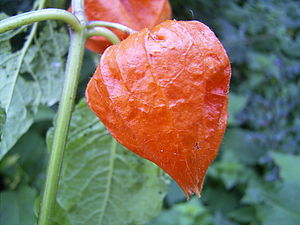Note: This is a project under development. The articles on this wiki are just being initiated and broadly incomplete. You can Help creating new pages.
Physalis alkekengi - Bladder cherry
Physalis alkekengi (bladder cherry, Chinese lantern, Japanese-lantern, strawberry groundcherry, or winter cherry) is a relative of P. peruviana (Cape gooseberry). It is easily identifiable by the large, bright orange to red papery covering over its fruit, which resembles paper lanterns.
Uses
Tentex forte, Muscle & Joint Rub, Impotency & Erectile dysfunction, Diarrhoea, Pharyngitis & Sore Throat, Toothache, Pyorrhea, Common Cold, Childhood apraxia of speech, Delayed Speech Development.
Parts Used
Chemical Composition
Like a number of other species in the genus Physalis, it contains a wide variety of physalins. When isolated from the plant, these have antibacterial and leishmanicidal activities in vitro.It also contains caffeic acid ethyl ester, dehydro-physalin L, physalin D, and cuneataside E[1]
Common names
| Language | Common name |
|---|---|
| Kannada | |
| Hindi | Akarkara |
| Malayalam | Akkarakaaram |
| Tamil | |
| Telugu | |
| Marathi | NA |
| Gujarathi | NA |
| Punjabi | NA |
| Kashmiri | NA |
| Sanskrit | Akarkarabh |
| English | Pellitory |
Habit
Identification
Leaf
| Kind | Shape | Feature |
|---|---|---|
| Smooth | Alternate, Pinnate | Alternate or opposite, stalked. Leaf blade widely ovate, usually blunt-based, with entire margins–sparsely large-toothed, sparsely short-haired |
Flower
| Type | Size | Color and composition | Stamen | More information |
|---|---|---|---|---|
| Unisexual | 15–20 mm (0.6–0.8 in.) wide | yellowish white | Stamens 5 | Regular (actinomorphic), fused, wheel-shaped, 5-lobed, underside hairy. Calyx fused, 5-lobed, initially campanulate, green; spreading, concealing berries after flowering, eventually 25–50 mm (1–2 in.) long, oval, yellowish red, anthers tight against corolla tube |
Fruit
| Type | Size | Mass | Appearance | Seeds | More information |
|---|---|---|---|---|---|
| Syncarp (sorosis), subglobose or ellipsoid with long echinate processes, orange when ripe | seeds many, ovoid. | {{{6}}} |
Other features
List of Ayurvedic medicine in which the herb is used
- Vishatinduka Taila as root juice extract
Where to get the saplings
Mode of Propagation
How to plant/cultivate
It is a popular ornamental plant, though it can be invasive with its wide-spreading root system sending up new shoots some distance from where it was originally planted. In various places around the world, it has escaped from cultivation[3]
Commonly seen growing in areas
Photo Gallery
References
External Links
- Ayurvedic Herbs known to be helpful to treat Tentex forte
- Ayurvedic Herbs known to be helpful to treat Muscle & Joint Rub
- Ayurvedic Herbs known to be helpful to treat Impotency & Erectile dysfunction
- Ayurvedic Herbs known to be helpful to treat Diarrhoea
- Ayurvedic Herbs known to be helpful to treat Pharyngitis & Sore Throat
- Ayurvedic Herbs known to be helpful to treat Toothache
- Ayurvedic Herbs known to be helpful to treat Pyorrhea
- Ayurvedic Herbs known to be helpful to treat Common Cold
- Ayurvedic Herbs known to be helpful to treat Childhood apraxia of speech
- Ayurvedic Herbs known to be helpful to treat Delayed Speech Development
- Herbs with Dried Roots used in medicine
- Herbs with Leaves used in medicine
- Herbs with Flower used in medicine
- Herbs with common name in Hindi
- Herbs with common name in Malayalam
- Herbs with common name in Sanskrit
- Herbs with common name in English
- Habit - Perennial herb
- Index of Plants which can be propagated by Seeds
- Index of Plants which can be propagated by Cuttings
- Herbs that are commonly seen in the region of wasteland
- Herbs that are commonly seen in the region of gardens
- Herbs that are commonly seen in the region of Ornamental
- Herbs



